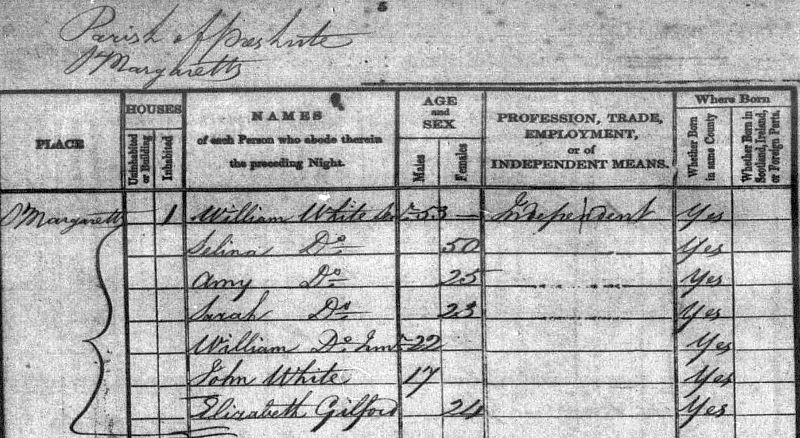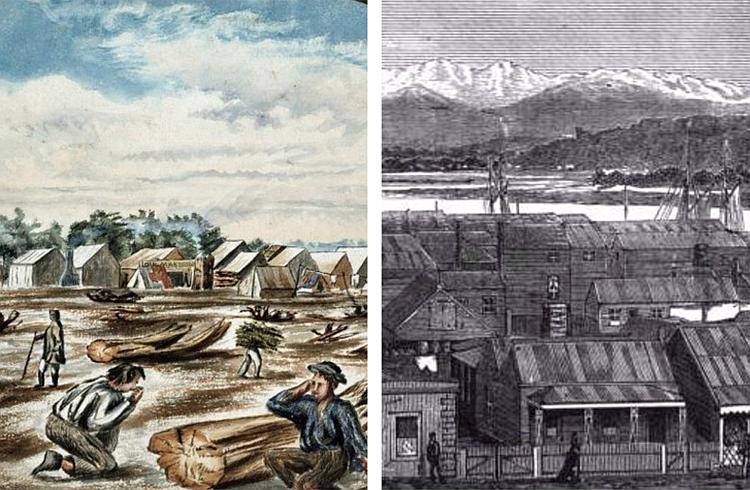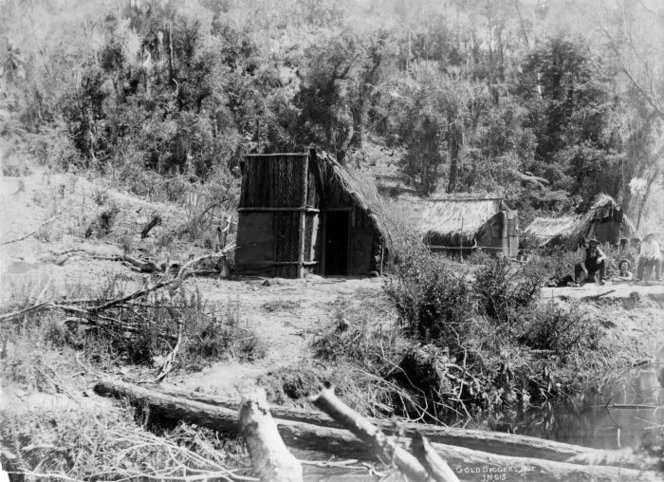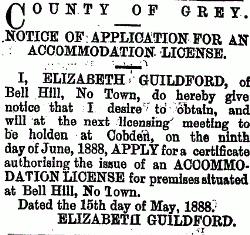 Click Slide menu on left Click Slide menu on left

Elizabeth GUILFORD
Elizabeth Guilford, daughter of
William and Ann Guilford was Baptised 01 Jun 1817 at Easton,
Wiltshire, England  Src: Wiltshire Archives - Easton Royal Parish RegisterIn 1841 now 24 years, she was
employed as a household servant at Marlborough
In 1859, when 41Y, Elizabeth took the challenge to leave England for New Zealand and join her brother John and his family
at Canterbury, New Zealand after years of insistance there were greater opportunities there waiting for her.
Elizabeth sought a immigration passage on the 676 ton
ship Regina Captain Thornton, . She boarded along
with 280 other passengers 29 Aug 1859 and the ship sailed from Gravesend on Sep
2nd. After a passage of 13 weeks she arrived at the Port
of Lyttelton on 04 Dec 1859 and would have been greeted
eagerly and together the reunited family would have made their way up
the bridle path to rest at the top and view the plains ahead - we wish we could have known her thoughts when comparing it with the land left behind and now, John would see the advances made when hecompared it to the barren sight that greeted him 8 years before. At Heathcote there was not yet a bridge built so a
ferry took them and Elizabeth's possessions across the river
and then on by dray to Christchurch.
Work as a servant was
plentiful but we have no record of Elizabeth's life, any events or
location during those first years but in the
Nelson Examiner and
New Zealand Chronicle, 1861, Shipping Intelligence.ENTERED INWARDS.
January 12, I. R. M. Steamer Prince Alfred, from Wellington.
Passengers for Nelson —Second cabin : Miss
Guilford,.
In Nelson
1865 -17 January 1865, we find Elizabeth has a house: TOWN ASSESSMENT—
NELSON. BOARD OF WORK 3. EIGHTH YEAR. NOTICE is hereby given, that a
RATE of Three Farthings in the Pound, upon the assessed value of the
PROPERTY included within the TOWN of NELSON, has been made by the BOARD
of WORKS; and the said rate is required to be PAID to the Secretary, at
the Board of Works Office, Market-place, Nelson, on WEDNESDAY, the 8th
day of February, 1865. In accordance with the " Nelson Improvement
Amendment Act," " the names of the persons liable for the payment of
such rate, and the amount payable by each of such persons, are published
for general information. £ s. d. Guilford, E ; £0 10s
0d
4 April 1865,
GOVERNMENT NOTICES. LIST of UNCLAIMED LETTERS remaining in the
Post-office, Nelson, for the Quarter ending March 31,1865: Elizabeth
Guilford
In 1866 financially
stretched Elizabeth is forced to sell her home - Nelson Evening
Mail, 15 May: SALES BY AUCTION. IMPORTANT SALE OF VALUABLE TOWN
AND COUNTRY PROPERTIES. On SATURDAY, 19th instant, 12 o'clock sharp,
MESSRS. LOCKHART & CO. have received full instructions from the
Mortgagees to sell by Public Auction (unless previously settled) all the
right, title, and interest in the following Properties, viz Brick House
and Land, part of Town Acre 422, lately occupied by Miss
Guilford.
Elizabeth was living
at Nelson however in July 1868 the Nelson Examiner and New Zealand
Chronicle reported: 7 July 1868: CLEARED OUTWARDS. July 6, steamer
Airedale, 286, Kennedy, for Picton and Wellington. Passengers: saloon —
Miss Bonnington, Mr. and Mrs. Wilson and child and servant, Dr. and Miss
Greenwood, Miss Wells, Sir David Monro, Lady Monro, Major Richmond,
Messrs. Emerson, Collins, Wells, Parker, and Eyes ; second cabin — Mr.
Kennedy, Mr. Plowden, and Miss Guilford.
Elizabeth went to the West Coast - her nephew Henry John
wrote in his diary 1911 that "For some years she lived in Christchurch,
then went to Nelson, thence to the "West Coast" where for a number
of years she carried on a Storekeeping business at Charleston." Nephew William and brother to
Henry, briefly went goldmining on the coast before his marriage, and
would certainly made contact but after that she was with
family. In 1869 letters received during the month of July, 1869 at Hokitika addressed to Miss Guilford remained unclaimed and continued to be
advertised monthly till the end of November .

Left: Hokitika Beach abt 1870 by
Theodore
Octavius Hurt, On right, Hokitika township
about 1875
The ebb and flow of population was immediate
following the lure of instant wealth: "A report on the state and
prospects of the new rush at the Teremakau, is published in another
column, and it may be seen from a perusal of it that the news is of
a most cheering description. It is long since any extensive new ground
has been opened up in the locality of the Teremakau, or indeed if any
portion of the Waimea or Hokitika district, and the present discovery
should have the effect of imparting fresh hopes to  prospecting
miners and expectations of an improved condition of affairs to the
business people of this and the neighbouring district. The universal
depression which has certainly existed on the Westland gold-fields for
some time past, will require perhaps stronger stimulants than the
present rush to remove it finally, but it is in platter for
congratulation that the falsity is proved of the too often repeated cry,
that all the payable alluvial ground has been worked out. The fact that
the days of important alluvial rushes have not gone by for ever, may
tend towards the dissolution of the singular enchantment which distance
lends to the view of the West Coast miners, who have been too easily
deluded by exaggerated of gold discoveries in far away lands, and too
heedless of riches which lay at their feet." prospecting
miners and expectations of an improved condition of affairs to the
business people of this and the neighbouring district. The universal
depression which has certainly existed on the Westland gold-fields for
some time past, will require perhaps stronger stimulants than the
present rush to remove it finally, but it is in platter for
congratulation that the falsity is proved of the too often repeated cry,
that all the payable alluvial ground has been worked out. The fact that
the days of important alluvial rushes have not gone by for ever, may
tend towards the dissolution of the singular enchantment which distance
lends to the view of the West Coast miners, who have been too easily
deluded by exaggerated of gold discoveries in far away lands, and too
heedless of riches which lay at their feet."
This may have been the reason that
Elizabeth went to Bell Hill - it
was noted
for goldmining was situated 19.3 km SE Ngahere
THE BELL HILL
ROAD. West Coast Times, 30 July 1872: The following is the Chief Surveyor's report on the
proposed road from the 32nd mile-post., Christchurch Road, to the
Arahura Township : —
The country to be
traversed between the Teremakau and Lady Lake, a distance of about
eleven miles, is flat, offering every facility for the construction of a
road; gravel is to be had almost anywhere by sinking to a moderate
depth. The land along this part of the road is of superior description,
comprising about 20,000 acres of the best alluvial ground in the
country. A great number of creeks require to be crossed, the moat of
them with hard gravel bottom, and consequently not necessitating the
construction of bridges or even of culverts to open the road. From Lady
Lake to Bell Hill a distance of about five miles, the road for the most
part would run along the foot of Granite Hill spurs and Jones' Hill, all
terraces of a gentle incline and offering no difficulties to road
construction.
On the whole, the
proposed dray-road would follow the present bridle-track from the
Teremakau to Bell Hill — a track which has been in use for some time —
and which with the exception of several parts, amounting together to
about two and a half miles, is as good a line of road through that
district as can be selected.
From Bell Hill to
Hatters' Terrace and Try-again (two digging townships on Nelson Creek),
a distance of about twelve miles, the road for the first four miles will
follow the present track to Camp Town by way of Kangaroo Creek. At a
distance of about three miles from Bell Hill, a swamp of from forty to
fifty chains in width requires to be crossed before the terraces at the
headwaters of Red Jack's Creek and tributaries can be reached.
Swamps as a rule
present formidable difficulties to the construction of roads. In
Westland, however, it has been found that the construction of roads over
swampy land (Pakihis) is no more difficult, and in some cases less so
than the construction of roads over comparatively sound ground, and in
all cases where Manuka scrub is found covering the swampy land, gravel
and conglomerate is struck at a depth of from two to five feet.
After crossing the
swamp the road may follow along the foot or top of the terrace land into
the right hand branch of Nelson Creek to Hatters' terrace and Try-again.
From Try-again to the Ahaura Township, by way of Callaghan's (another
digging township), no obstacle intervenes. The distance is about five
miles, and a pack-track is connecting these places at present. I may
here mention that at the time of my last visit to the Ahaura Township,
the people were about taking steps to petition the Provincial Government
of Nelson for the construction of a road from Ahaura to the Arnold by
way of Callaghan's and Try-again. If, therefore, the road from Greymouth
to Ahaura was taken through Try-again and Callaghan's, a distance of
five miles in the construction of the Bell Hill road would be saved.
From the above it
will be seen that the total length of the proposed road is about
thirty-four miles, and that, with the exception of the part from Nelson
Creek to the present track from Camp Town to Bell Hill, by way of
Kangaroo Creek, the practicability of constructing a dray-road as
proposed, has been established, and I venture to predict that on survey
it will be found that the route sketched out can be much improved upon,
and that the distance between the Christchurch Road and the Ahaura
township can probably be shortened.
On referring to the
Canterbury lithographed maps, I find " Old Maori track to Ahaura" marked
east of Lake Brunner, and over the country which it as proposed the new
road should traverse. This little 'incident of itself, does, to my mind,
satisfactorily settle the question of the practicability of taking a
road that way, and is a guarantee to me, that the difficulties of doing
so are small, for I have found invariably those the best passes and
lines of communication on this Coast, which on the old Canterbury maps
were noted as "Maori Pass," or " Maori Track."
Together with
this, I forward a tracing and lithographed plan of the Grey Valley,
showing roads and tracks referred to in this memo. * Gerhard Mueller, Chief Surveyor.
PLEASE READ THIS
CAREFULLY! ELIZABETH IS FOUND!
1878 - Grey River
Argus, 13 June - NO TOWN. Jacob Bradwell, an out and out
Geordie, has just paid No Town a visit after an absence of seven years,
and he was most cordially welcomed by those of his old associates still
in the land of the living and residing in or near the township. Jacob is
one of those renowned hatters in gold-mining who are fast becoming
scarce, and being an old coal-hewer of the Durham fields he is quite an
adept in all kinds of hard work. The enterprise he has displayed, and
the amount of labor he has done quite single handed in his alluvial
claim at Bell Hill, is something astonishing. . When he started his
present work his few neighbors, or "co-mates in exile," christened his
claim the "Labor in vain." Jacob informs me that he has been engaged
over two and a-half years in getting his ground into working order; that
his water-race, which carries 20 heads, is over a mile in length and his
tail-race over one hundred yards with a face of gravel to work upon 80ft
in depth, and that he had 3 boulders to contend with of enormous size,
added to all which Jacob has many a time, when tucker ran short, lived
for days on cabbage leaves, and in the absence of tobacco, smoked tea
and the dried leaves of manuka scrub.
In this out of
the way diggings at Bell Hill, where fine-looking quartz reefs are
reported to exist, five or six miners and one elderly female have lived
from year to year in almost primitive style, seldom hearing anything of
the outer world, save when the packer of their three months' supplies
visits the locality. And yet they live happily enough together, never
quarrel with each other, have nothing to gossip about, but yarn with one
another at night, and doubtless conjure up incidents of bye-gone days,
when gold was more plentiful and themselves more foolish than now, in
the matter of throwing money away; know as much about candidates for
Parliamentary or County Council honors as they do about the feather clad
inhabitants of Mars, and jog on in their quiet pursuit of gold under
difficulties in a way that is really astonishing. Miss Gilford, the
femme sole of Bell Hill, who has been located there for years, is an
English lady, possessed of considerable energy and pluck, as can readily
be understood, and from what I have been told, and all that I have seen
at a personal interview, seems to have acquired the position of general
adviser to the limited community of which she may be termed the Forest
Queen. She can, and frequently does, lend a willing hand to any of the
men in their claims; is an adept with the long-handed shovel
occasionally wears gum boots and wide-awakes of a Yankee pattern ; and is
altogether a most remarkable woman, and one whom the male recluses of
Bell Hill would go many miles to serve. Strange community and altogether
outlandish, and yet who knows they may in the future be known as the
resolute .pioneers of an extensive goldfield and the joint winners of a
Government or a County prize. At present the Bell Hill residents get all
stores, &etc, packed from No Town, but I understand that Mr John
Molloy, a settler at Deep Creek, has come to terms with the County
Council to cut a pack track from Big Bill's Gully to Bell Hill, and that
he is now engaged in performing this very necessary piece of
work.

Bush scene and gold diggers hut, possibly in
Westland, photographed circa 1890s by Josiah Martin.
1886 - Grey River Argus, 13 November
1886: (The reason Elizabeth wore gumboots) Bell Hill is still
living in hope that the County Council will make a track into the place.
In all reason, why has this portion of the district been neglected In
the manner it has been? If my memory serves me, a miner at Bell Hill
lately made an offer to the County Council to make a track from Bell
Hill to the Government track for £15. Why was Councillor Parfitt silent
then ? There is no person better acquainted with the beastly state of
this track than Councillor Parfitt is. If Councillor Parfitt and the
rest of the Councillors were compelled to carry their week's tucker into
this place I am perfectly satisfied that before they would make a second
trip the just claims of the Bell Hill miners would be taken notice of.
It is to be hoped that some Councillor having the interest of gold
mining at heart will move in this matter, and if possible get a cheap
track to enable miners to get in and out of this place without wallowing
to their knees in mud.
I see by the report of the last sitting of
the County Council that the Council has agreed to remove the bodies from
the Try Again Cemetery. Too much credit cannot be given to Councillor
Guinness and Clifford for having contributed their might in removing
from amongst us what has been a standing disgrace to the district for
years. It is to be hoped that the Council in calling for tenders for the
removal of these bodies will include the bodies lying in other parts of
the district namely, one at Bell Hill, one at Fenian Creek, and one at
German Gully.

Grey River
Argus, 3 August 1887: GREY COUNTY COUNCIL. Tuesday, August 2. The
county council met this evening. Letter from H. P. Pow in reference to
the notice he received that the council would deduct L2O from his
contract money, and asking that the fine be not enforced, on the ground
that he had done what work was pointed out to him as wanted.
Referred to the Road Overseer. Another letter from the same person
stated that in consequence of the unfair way in which he had been
treated by the council's servants he wished to resign contract No. 3
Grey Valley Teremakau road to A. Shaw, W. J. Shaw and Miss E. Guilford.
Also, a subsequent letter stating that he had sold his contract for £24
to the above persons.
Resolved that Pow be allowed to transfer the
contract on condition that the sureties be approved of. The second
letter was also referred to the Road Overseer to report. Letter from
Ellis Hall asking the council not to pay Pow more than half the money.
He was Pow's partner, and had done his share of the work, and now he
found that Pow had sold the contract to Miss
Guilford
Grey River Argus, 3
September 1887: Tuesday, 6th September, 1887, AT 7.30 P.M. Cr McCarthy
to move : That a sum of £10 be expended in repairing branch track from
Miss Guilford's store, Bell Hill, to junction of Nelson Creek
road.
Grey River Argus, 9
September 1887, GREY COUNTY COUNCIL. Wednesday, 7th September.
Cr
McCarthy moved— "That a sum of £10 be expended in repairing branch track
from Miss Guilford's store, Bell Hill, to junction of Nelson Creek
road." Cr Parfitt seconded. He corroborated the statement of the mover
that horses had to be unloaded before getting to the store. — Cr
Marshall thought that £5 would do all that was required. The amount was
reduced to £5, and motion agreed to.
DEATH. GUILFORD— On
the 21st. February, at the Grey River Hospital; Elizabeth Guilford,
native of Easton, near Malvern, Wiltshire, and late of Bell Hill, aged
75 years. Her burial was at Greymouth Cemetery February 24, 1892.
Today, the traveller
after leaving Reefton on Route 7 now heads south toward Greymouth. Turn
left at Ngahere to Nelson Creek and continue on the Nelson Creek Bell
Hill Road. It's a long drive about 30 km mostly on an unsealed road.
Bell Hill is a historically rich area in timber farming and gold
mining.
|









